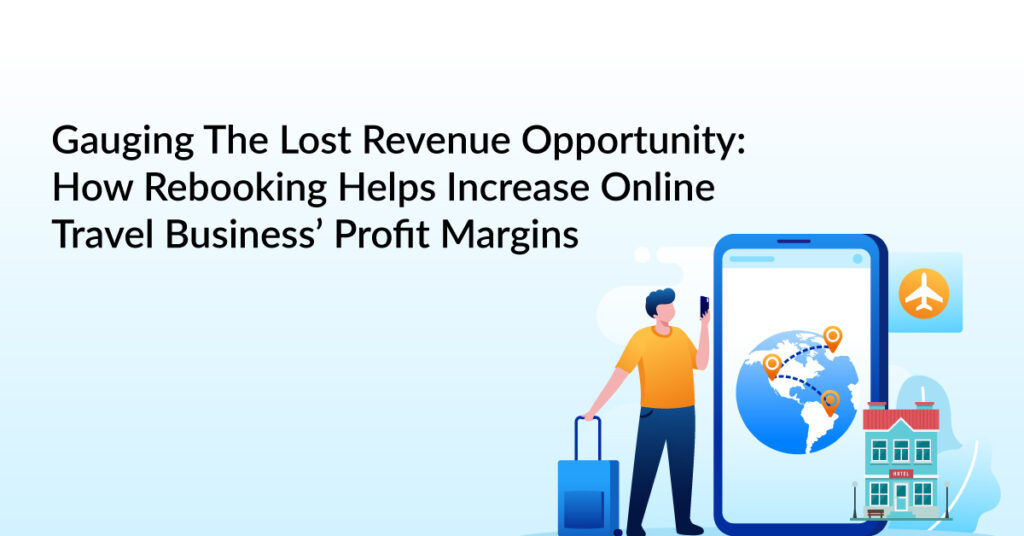The travel landscape is becoming increasingly competitive. While the competition is increasing, online travel booking businesses are under pressure to maximize profit margins.
With constant fluctuations in hotel rates, often daily & mostly hourly, many of the travel businesses miss out on the hidden opportunity to capitalize on the revenue gap created by hotel price fluctuations.
This revenue gap is exactly what ‘rebooking’ fills.
With the right profit optimization strategy, travel businesses can ensure capturing price fluctuations and increase net profit on every rebooked hotel room.
In this article, we’ll explore how online travel businesses lose revenue without automated rebooking, how ‘rebooking’ helps increase net profit, reasons why rebooking is a great strategy, and how online travel businesses can rebook easily.
Let’s begin by understanding how businesses lose revenue in case of hotel price drops?
How do hotel price drops impact OTA revenue?
Hotel prices drop & rise all the time. Reasons? Could be many! Off-season, major events, bad reputation, low footfall, booking cancellations, etc.
For example, during the 2022 World Cup in Qatar, hotel prices surged by 40% as global demand flooded in.
In most cases, travel companies lock in a price at booking and never look back. However, studies show that hotel rates drop after booking in at least 15-25% of cases.
Hotel price fluctuations are a double-edged sword for OTAs. When hotels lower their rates, it often means OTAs earn lower commissions, as their earnings are typically a percentage of the total booking cost.
Let’s understand this with the following video:
Additionally, many travelers now use price-tracking tools and rebooking services, canceling their original reservations to take advantage of new, lower rates. This results in lost revenues, which must either absorb the losses or find ways to optimize pricing strategies.
For instance, if an OTA has a 15% commission model and the price of a hotel room drops from $200 to $180, the commission falls from $30 to $27 per booking.
While this seems like a minor difference, when scaled across thousands of bookings, it leads to substantial revenue erosion. The next section throws light on the substantial revenue loss that occurs during hotel price drops.
How Much Revenue Is Lost Without Rebooking?
Without an automated rebooking strategy, travel businesses and OTAs miss out on a significant revenue stream. Studies show that hotel prices fluctuate multiple times before check-in, with price drops occurring in as many as 40% of cases.
If online travel businesses do not capitalize on these fluctuations, they lose the opportunity to increase their margins.
For instance, an OTA with an annual booking volume of $50 million could improve profitability by 2-5% by leveraging rebooking technology. That’s an additional $1-2.5 million in potential profit left untapped. Without rebooking, this revenue is lost to price-sensitive travelers who actively search for better deals elsewhere.
Also Read: A quick guide to profit maximization for online travel business
How Rebooking Impacts Net Profit of Your Travel Business
What if you could automatically secure a lower hotel booking price from another supplier even after a booking is confirmed?
Rebooking isn’t just about cutting costs- it directly impacts the net profit of a travel business. Rebooking or profit maximization technology automatically secures better rates on existing bookings that helps OTAs increase their profit margins without additional marketing expenses.
Since rebooking occurs on confirmed bookings, there’s no risk of customer churn but an opportunity to improve profitability. Here’s a flow chart of how it works:

Let’s understand this with a scenario-
A travel agency processes 100,000 bookings a year and saves an average of $15 per booking through profit maximization tech, that translates to $1.5 million in extra profit annually. These savings add up, helping OTAs and travel businesses build a more sustainable and competitive revenue model.
Low Risk, High Reward: The Benefits of Rebooking
Rebooking is a rare profit maximization business strategy that offers substantial rewards with minimal risk. Some of the key benefits of implementing a profit maximization strategy can be summed up as:
1. Higher Margins- Rebooking ensures OTAs secure the best rates without lowering their commission percentage.
2. No Additional Customer Acquisition Costs- Instead of spending money on marketing to attract new customers, businesses can increase profitability from existing bookings.
3. Improved Customer Loyalty- Travelers who experience price adjustments in their favor are more likely to book through the same OTA again.
4. Competitive Advantage- Offering automatic rebooking as a feature differentiates a travel business from competitors that do not provide this service.
While those are the benefits, you must be wondering how to implement a robust rebooking strategy and maximize profits. We talk about it in the following section.
Take Away- Act Smart & Capture Higher Revenue
In an industry where profit margins are often tight, rebooking offers a practical and effective way to boost profitability without the risk.
To make the most of hotel price drops, online travel businesses can adopt Profit Maximization Tools that use data analytics to monitor price fluctuations in real-time, raise an alert when the prices drop, and give you an option to rebook rooms from your preferred supplier, when a lower price becomes available.
With hotel price fluctuations happening frequently, failing to capitalize on price drops results in significant revenue losses. Travel businesses that adopt automated rebooking will be better positioned to thrive in an increasingly competitive market.







